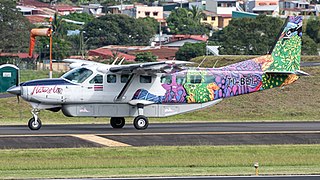SAM was a Colombian airline. With its main hub at El Dorado International Airport in Bogotá, SAM operated domestic and international routes and was a subsidiary of Avianca. In 2004, its headquarters were in the Avianca headquarters in Bogotá.
Transportes Aereos del Continente Americano, operating as Avianca El Salvador, is an airline owned by Kingsland Holdings and based in San Salvador, El Salvador. It is one of the seven national branded airlines in the Avianca Group of Latin American airlines, and it serves as the flag carrier of El Salvador.
Avianca Costa Rica S.A., formerly known as LACSA, minority owned by the Synergy Group, is the national airline of Costa Rica and is based in San José. It operates international scheduled services to over 35 destinations in Central, North and South America. The airline previously used the TACA/LACSA moniker when it was a subsidiary of Grupo TACA. Since May 2013, following Avianca's purchase of Grupo TACA, Avianca Costa Rica became one of seven nationally branded airlines operated by Avianca Group of Latin American airlines.
This is a list of aviation-related events from 1969.
This is a list of aviation-related events from 1975.

La Aurora International Airport serves Guatemala City, Guatemala. It is located 6.4 kilometres south of Guatemala City's center and 25 km from Antigua Guatemala. It is administered by the General Directorate of Civil Aeronautics.

Servicio Aéreo de Honduras S.A. otherwise known as SAHSA Airlines was the national flag carrier airline of Honduras from October 22, 1945, to January 14, 1994. The airline was a subsidiary of Pan American Airways and merged with Transportes Aéreos Nacionales (TAN) to form TAN-SAHSA in November 1991.

The Uruguayan Air Force is the air service branch of the Armed Forces of Uruguay. Originally created as part of the National Army of Uruguay, the Air Force was established as a separate branch on December 4, 1953. It is the youngest and also the smallest branch of the Armed Forces of Uruguay. In 1977 it was determined that the mission of the Air Force is to conduct strategic and tactical aerospace operations on behalf of the national defense, exercising the sovereignty of the Uruguayan airspace and defending the independence, integrity, constitution and laws of the country. The Air Force must also conduct search and rescue missions and plan, propose, execute and supervise the necessary measures for the development of the aerospace potential, while providing any necessary and possible logistical support during the natural disasters that the country may suffer. Since 1985 this has been always carried out under the command of the President of Uruguay, and according to the Minister of National Defense.

The Argentine Air Force is the air force of Argentina and branch of the Armed Forces of the Argentine Republic. In 2018, it had 13,837 military and 6,900 civilian personnel. FAA commander in chief is general Xavier Isaac.
Air Panama is a regional airline based at Albrook "Marcos A. Gelabert" International Airport in Panama, and is currently the second-largest air carrier in the country, surpassed only by Copa Airlines. The carrier offers both scheduled and charter passenger flights to more than 31 destinations from its hub at Albrook International Airport.

LADE - Líneas Aéreas del Estado is an airline based in Comodoro Rivadavia, Argentina. It is a state owned airline operated by the Argentine Air Force and provides domestic scheduled services mainly in Patagonia.

Nature Air was a regional airline headquartered in San José, Costa Rica that offered a scheduled service to a range of tourist destinations in Costa Rica, Panama and Nicaragua. It operated scheduled domestic and international services, as well as charter services with turboprop aircraft. Its hub, operations and maintenance base was Juan Santamaría International Airport (SJO) having moved in 2013 from its original location at Aeropuerto Internacional Tobías Bolaños (SYQ). Claiming to be the world's first carbon neutral airline, it was one of the first airlines to publicize its sustainability credentials during a period of rapidly-expanding interest in eco-tourism. Nature Air received a number of awards, including a Global Vision Award for Sustainability from Travel + Leisure magazine in 2011. Its fleet consisted primarily of DHC-6 Twin Otter and Cessna 208 Grand Caravan turboprop aircraft that were ideally suited to short takeoff and landing characteristics of its destinations which often featured gravel or limited-paved landing strips. In 2010, Nature Air advertised 74 daily flights to 15 destinations in Costa Rica, Nicaragua and Panama. On 31 December 2017, all 10 passengers and two pilots aboard Nature Air Flight 9916 were killed in an aerodynamic stall shortly after takeoff from Punta Islita airstrip. Although the accident was ultimately determined by the NTSB to have been caused by pilot error, Nature Air stopped flying in January 2018 and its operating license was indefinitely suspended by the civil aviation authority of Costa Rica on May 2, 2018 leading to the closure of the airline.

El Salvador International Airport Saint Óscar Arnulfo Romero y Galdámez, , previously known as Comalapa International Airport and as Comalapa Air Base to the military, is a joint-use civilian and military airport that serves San Salvador, El Salvador. It is located in the south central area of the country, in the city of San Luis Talpa, Department of La Paz, and occupies a triangular plain of 2519.8 acres, which borders the Pacific Ocean to the south, is bordered to the east by the Jiboa River, and to the northwest by the coastal highway. Being close to sea level, it allows aircraft to operate efficiently at maximum capacity. It is connected to the capital of San Salvador, El Salvador, through a modern four-lane motorway, with 42 kilometers travel in an average time of 30 minutes.

Aviateca Flight 901 was a scheduled international passenger flight which crashed into the 7,159-foot (2,182 m) San Vicente volcano in El Salvador on approach to the Comalapa International Airport on 9 August 1995. The accident killed all 65 passengers and crew on board and is the deadliest aviation disaster to occur in El Salvador. An investigation by the Civil Aviation Authority determined that pilot error and air traffic control error in bad weather contributed to the accident.

Arajet S.A. is an ultra low-cost airline and the flag carrier of the Dominican Republic. Operations began on 15 September 2022 with a flight to Barranquilla, Colombia.

Nature Air Flight 9916 was a chartered domestic passenger flight from Punta Islita Airport in Nandayure, Guanacaste Province, Costa Rica, to Costa Rica's capital San José that crashed into terrain on 31 December 2017 shortly after takeoff from Punta Islita Airport killing all 12 people on board. The flight, with a planned duration of 40 minutes, was operated by Costa Rican regional airline Nature Air and the aircraft involved was a Cessna 208 B Caravan manufactured in 2001. On board the aircraft were 10 passengers, mostly American tourists, and 2 pilots. An NTSB investigation later determined that the accident was caused by the aircraft entering an aerodynamic spin/stall that was the result of pilot error. Nature Air permanently ceased operations following the accident.
Aerocosta was a Colombian air company that transported cargo from 1965 to 1976. It had major stockholders, consisting of Floramerica (40%), Robert Camacho (25%) and private investors.











